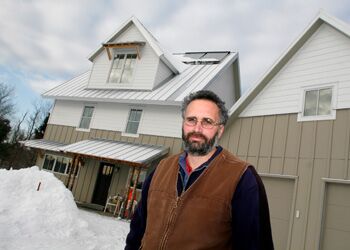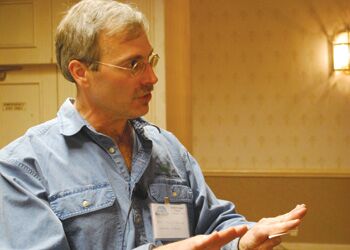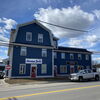Weathering a hit | Green builders say the returns on energy-efficient construction should help the fledgling niche grow, despite higher costs
The biggest clue that the house Dan Kolbert is driving up to is supremely energy efficient is not its rooftop solar panels, partly covered with snow, or its slightly futuristic look. Rather, the telltale sign is its old-fashioned overhangs, says Kolbert, the house’s builder. The front door is protected by a covered entrance and eaves suspended over the second- and third-story windows.
“A lot of this is traditional architecture,” says Kolbert, owner of Kolbert Building in Portland. Homes built before air conditioners often had roofs extending over windows. “Overhangs on windows prevent heat from coming in during the summer, and in the winter, they let it in.”
A sensible design that draws on old wisdom might be the roughly 2,200-square-foot Falmouth house’s most salient ecological feature, but to the untrained eye, it looks eye-catchingly modern, with a shiny silver roof and beige fiber-cement siding. Kolbert constructed the house, which was designed by Phil Kaplan of Kaplan Thompson Architects in Portland, in 2009 to meet the U.S. Green Building Council’s highest energy standards, or LEED platinum status.
The MacLehose family and their two Siamese cats live in the home, which on a chilly late-January day feels warm on the first floor, heated by hot-water piping embedded in a stained concrete slab floor. It’s a bit cooler on the second floor. The MacLehoses pay roughly $200 at the height of winter and $30 to $40 in the summer on their monthly utility bill. They don’t have a boiler or furnace. What they do have is a solar-heated water system that provides most of the family’s hot water and heats the radiant floor, as well as back-up on-demand hot water heater, dense cellulose insulation made out of recycled paper packed between double-sided walls and a ventilation system that circulates fresh air and helps prevent moisture buildup. The basic cost of the house, minus the garage, roadwork and some other extras, was about $325,000, according to Kolbert, including $26,000 for the solar hot-water system and solar panels.
Houses designed for a mostly imagined future, one in which oil is scarce and pricey, are still a novelty. Demand for efficient homes is growing, but not as quickly as those in the industry would like. “We’re just beginning on this road and we have a long way to go,” says Bill Hulstrunk, the technical manager for an insulation company based in Massachusetts.
Hulstrunk recently traveled to Portland to give his talk, “Beyond Energy Star: Building details for the next generation,” at a training conference for energy-efficiency professionals: the auditors, builders, architects, insulation contractors and others trying to push the building trades forward. The Maine Association of Building Efficiency Professionals, a trade group, organized the second annual conference to discuss technical know-how and the state of the industry, which is in flux due to dwindling federal stimulus dollars that fueled a burst of home weatherization projects in Maine. Also, the industry is still young, and it’s uncertain when the market might at last tip in its favor.
A rarity
When Hulstrunk drives along the roads of New England in wintertime, he always peers up at the pitched roofs of the homes he passes. If he sees a house capped with a thick blanket of snow, he knows the home is tight and warm, and losing little heat. But too often he observes dark patches of exposed roof and long icicles, evidence of snow leisurely melting on a warm roof. Those bald spots indicate wasted energy that’s likely racking up big bills for its occupants.
“Only one in 10 existing buildings is insulated to a high level in New England,” Hulstrunk says. Furthermore, less than 5% of new home construction is energy efficient, he estimates. Kolbert’s take on those sobering statistics? “Depressing,” he says. “I can’t tell you how depressing it is. We seem to be a suicidal species.”
In Maine, 25 home projects reflecting 93 housing units have been certified by LEED since 2006, meaning they met benchmarks set by the U.S. Green Building Council for energy efficiency. Energy Star, another rating system that started in the mid-1990s, has certified 1,054 homes in Maine. Overall, the U.S. Census’ latest count in 2009 tallied 704,574 housing units in Maine. The state also has the oldest building stock in the country and is the most reliant on No. 2 heating oil, according to Katye Charette, executive director of the Maine chapter of the U.S. Green Building Council. Even more urgent than constructing new homes is retrofitting existing ones, she says.
The last thing the state needs is more inefficient housing, Hulstrunk argues, pointing out that energy retrofits can be more costly than energy investments made during original construction. At the conference, he made the case that Americans need to build homes today that in 100 years can be sustained with their own energy, perhaps with photovoltaic panels or another alternative source.
Hulstrunk is the technical manager for National Fiber, which makes cellulose insulation and hydro spray mulch. Still, he seemed to speak as much from a personal vision as a professional one, and he has built his own super-insulated home in Vermont. “I saw how easy it was to do,” he says. “We use the same technique to build these homes, but we just configure them a little bit differently to build a high-performance home. It’s not beyond the capabilities of a conscientious builder.”
What might stop people from constructing such efficient buildings is the myth that fossil fuels will always be cheap, Hulstrunk says. This idea is compounded by the belief that if fossil fuels do run out, we can switch to renewable energy sources. But these sources will take years to build up to the levels we require for our current energy use, he says. And then there’s the myth that building codes ensure all new homes are efficient, he adds.
Maine’s new uniform building code, which went into effect Dec. 1, creates a baseline standard for energy efficiency for all new homes, Charette says. But a newly proposed bill aims to repeal the code. “If we can keep that [code], we will increase the number of energy-efficient homes,” she says.
Kolbert mentions, as well, that contractors need to become better educated in efficient building concepts and techniques. “We are all battling with the same issues,” he says. Informal monthly workshops for building professionals at the Maine Green Building Supply store in Portland and newly established annual training conferences, such as the one recently held in Portland, help, Charette and Kolbert say.
In the end, however, consumer demand will drive or stall this niche building market. “You still have to make the case for it with plenty of people,” Kolbert says.
Economics of energy efficiency
Of all the myths obstructing widespread investment in new energy-efficient homes, the stickiest one is that only the wealthy can afford such houses, according to Hulstrunk. He argues that homeowners need to spend less than an extra $25,000 on a new house to make it well-insulated — the most critical piece in energy efficiency. Moreover, it’s a good investment, he figures. “When fuel prices rise, these buildings will go up in price,” he says.
Charette and Kolbert were less willing to put a price tag on the additional money needed to construct a fully energy-efficient home, since so many variables go into designing and building a house.
For a home to continue to be a viable, affordable shelter a century from now, Hulstrunk insists it must be “super insulated,” a process that requires a 10% to 20% greater investment during initial home construction, but which a homeowner can earn back in a few years.
He offers builders a few tips on how to make effective sales pitches to customers. Right off, he points out that super-insulated homes are resistant to future fuel price fluctuations. “When oil prices double and triple, what will we do with the housing stock we have?” he wonders. Plus, many people like living in homes that reduce their carbon footprint, and heavily insulated homes are more comfortable and have better sound barriers, Hulstrunk says.
Along with talking a lot about insulation at the conference — and mentioning many technical details including how much wood to use in framing (as little as possible), the value of triple-glazed windows, window-to-floor ratios and foam sheathing — Hulstrunk covered simple design details that can save money. He told his audience they should build smaller homes, which are easier to heat, such as with wood stoves. Doubling a house’s size more than triples its annual heating and cooling costs. “I have some difficulty with people who say they want to build a 20,000-square-foot efficient home,” he says. Basic designs, such as compact homes, are also less expensive to build. Finally, and perhaps most obviously, homes should be oriented south to make it easier to fit or retrofit a roof with solar hot water and photovoltaic panels, he says.
Back in Falmouth on a recent afternoon, Stew MacLahose watches TV with his 11-year-old son in their super-efficient home, his two cats sharing his lap. Accustomed to having people tour his unique home, he talks happily about his concrete floor and the time it takes to warm up, the house’s siding and windows, the light bulbs he uses and the thermostat’s current temperature. On what motivated him to build such a home, he says, “It just seemed wasteful to do it otherwise, especially because we were building a new house.”
Rebecca Goldfine, Mainebiz staff writer, can be reached at rgoldfine@mainebiz.biz.












Comments